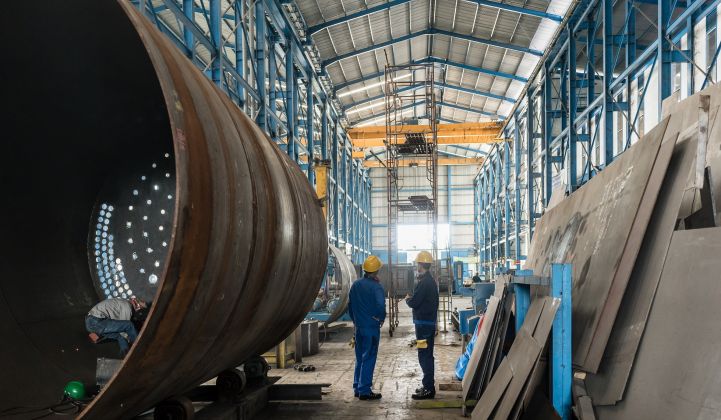Throughout his campaign, President-elect Joe Biden made it clear that building back better with clean energy would mean millions and millions of new jobs for Americans. And he’s right: Clean energy jobs are, in fact, better jobs. The proof is in the numbers.
A recent analysis of federal data shows workers in the clean energy sector — which includes renewable energy, energy efficiency, grid modernization, storage, clean fuels and vehicles — earn 25% more than the national median wage. Jobs in wind and solar power, for instance, pay a $24.85 hourly median wage, beating not only the national median of $19.14 but also the majority of fossil fuel jobs, which paid an average of $24.37 an hour last year. Moreover, unlike fossil fuels, clean energy occupations are found in every state, regardless of geology or geography.
Clean energy jobs are also more likely than others in the private sector to come with health care and retirement benefits. Approximately 90 percent of clean energy’s welders, cutters, solderers and brazers — the workers helping construct, manufacture and maintain renewable equipment across the country — received health care and retirement benefits from their employer. That’s over 20 percent better than the private-sector average.
The fact that clean energy directly addresses our growing climate crisis makes these jobs all the more attractive. A recent Morning Consult poll found that members of Gen Z are most interested in pursuing careers in energy sectors that do not contribute to climate change, namely, solar and wind.
It’s great that these jobs are desirable because opportunities in the clean energy sector are expected to significantly grow over the next decade. In September, the U.S. Bureau of Labor Statistics (BLS) once again listed wind turbine technicians and solar installers as two of the fastest-growing occupations in America.
Heading into 2020, the clean energy industry was expected to add another 175,000 workers. But the COVID-19 pandemic hit the sector hard and, unfortunately, the recent BLS figures fail to capture the disproportionate impact the pandemic has had on our workforce.
Before the pandemic, nearly 3.4 million Americans worked in clean energy. That’s more than work in real estate, banking or agriculture, and three times the number of Americans who work in fossil fuels. But we’re finishing 2020 down 446,000 clean energy jobs. At the current growth rate, it would take about three years for the sector to reach pre-pandemic employment.
If policymakers are serious about getting Americans back to work in high-quality, good-paying jobs, they should turn their attention to clean energy.
Recent history shows us the path forward, and it’s one that was spearheaded by President-elect Biden during his tenure as vice president in the Obama administration. From 2009-2015, smart policies created as part of the American Recovery and Reinvestment Act, the stimulus program launched after the Great Recession, helped clean energy drive national economic recovery.
Those policies used $90 billion in federal clean energy investment to leverage an additional $150 billion to generate over 900,000 job-years (defined as a full-time job for one year). That investment built over 104,000 renewable energy projects, or enough pollution-free electricity to power 8 million homes.
We can do it again.
The recovery presents an opportunity for the incoming Biden administration and Congress to create more jobs in industries and occupations that provide higher wages and benefits than the industry sectors most impacted by the current economic downturn. It also opens up the opportunity to make headway on the emissions reductions that scientists tell us are essential to avoid the worst economic impacts of climate change.
What we need most urgently right now are policies that allow current projects to move forward in spite of the COVID-related downturn. The American Council on Renewable Energy (ACORE) and its members believe that a key step in this direction will be for Congress to enact temporary refundability for renewable tax credits, so projects can be completed in a COVID-constrained tax equity market. We are also seeking a delay in the scheduled phase-down of existing credits, in recognition of the adverse nationwide impact the pandemic has had on renewables deployments this year.
Similarly, by expanding commonsense energy-efficiency programs, we can put people back to work making our homes, offices, schools and other buildings more energy-efficient. This effort comes with the additional benefit of saving cash-strapped businesses and consumers money with every monthly power bill. Energy efficiency is the largest employer in the U.S. energy sector, employing nearly 2.4 million Americans who earned a median wage of $24.44 an hour last year. Unfortunately, nearly 315,000 remain out of work since the pandemic.
Enacting commonsense emergency relief measures into law will get workers back on the job in every state, keep us from falling even further behind on our climate commitments, and immediately help the clean energy sector power the nation’s economic recovery.
***
Gregory Wetstone is president and CEO of the American Council on Renewable Energy, a national nonprofit that unites finance, policy and technology to accelerate the transition to a renewable energy economy.
Bob Keefe is executive director of E2, a national nonpartisan organization of business leaders who advocate for policies that are good for our economy and good for our environment.




